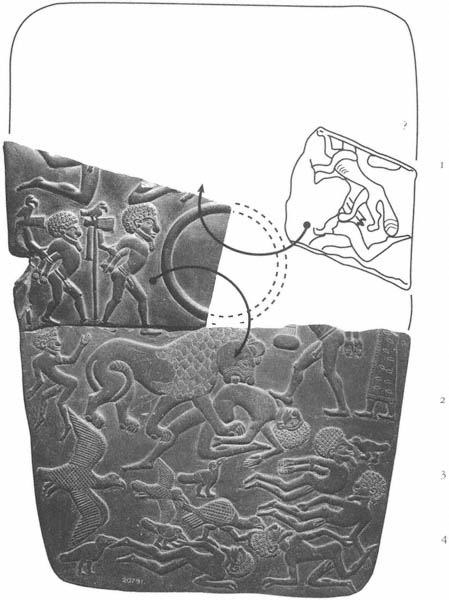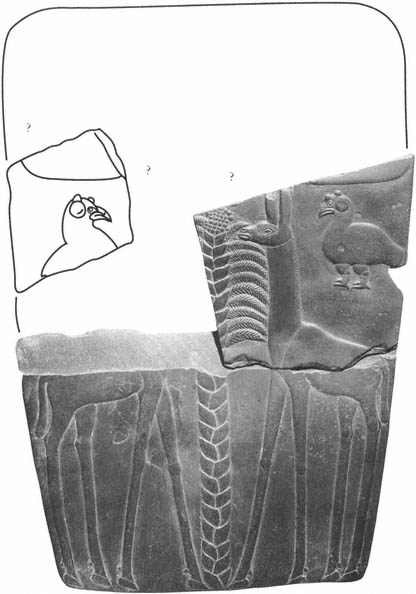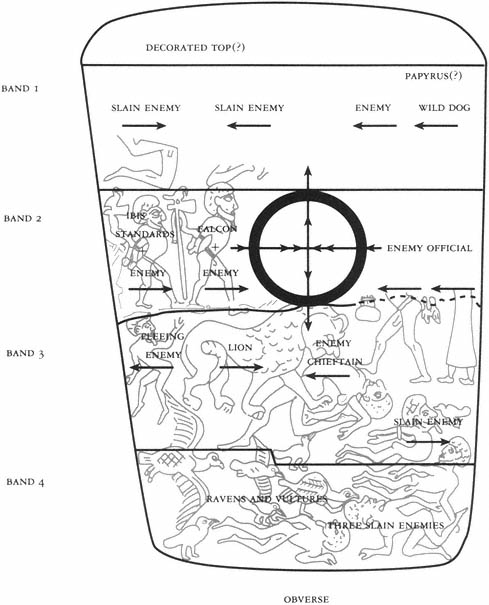Parts and Sides
The missing top edge should perhaps be reconstructed like the top of the Narmer Palette to display "heraldic" animal heads, a "royal"-palace-facade emblem (serekh ), and hieroglyphs giving the ruler's name. But excluding this symbolic border—on the Narmer Palette it is related to, not directly part of, the narrative image—the Battlefield, like the Hunter's Palette, presents four principal groups of figures, each including four agents or actors (Fig. 34).
On the Battlefield Palette, however, the textual positions of the groups are reversed. Rather than appearing at the top and bottom of the image, the two episodes closest to the moment of the blow are brought together into the center
Fig. 33.
Battlefield Palette: carved schist cosmetic palette, late predynastic (Nagada III) or early First
Dynasty. Ashmolean Museum, Oxford (top fragment, photo), and British Museum, London
(bottom fragment, photo).
Photograph courtesy of British Museum; line-drawing restoration of the palette includes
fragment from Kofler-Truniger Collection, Lucerne, Switzerland (top right edge).
Fig. 34.
Groups of figures on the Battlefield Palette, obverse.
of the composition. The other elements of the story are pushed to the outside, to the top and bottom of the image. In general, then, in comparison with the Oxford and Hunter's Palettes (Figs. 26, 28) the central area on the Battlefield Palette, including the cosmetic saucer, is given over more directly to the depiction of the ruler's power and danger. This rearrangement can be regarded as a continuation of the process we have been tracing through the entire chain of replications in which the ruler's presence—beginning outside, circling, and at the sides or edges of the depicted scene—is advanced into it.
If the Battlefield Palette presents an encounter with the ruler's blow at the visual and temporal center of the viewing of the image, the blow itself, as on the earlier works, is not depicted. Required in the narrative chronology of events and implied in the arrangement of those events, it is deflected from view in the pictorial text. Although this general device is the fundamental text of late prehistoric representation, its replication on the Battlefield Palette, like every other one examined here, has its own dynamics.
Each of the four groups of figures in the image forms a rough register band, especially by comparison with the groups of figures on the Oxford and, to a lesser extent, the Hunter's Palettes (Figs. 26–29), which occupy irregular fields in the compositions, arrayed in relation to one another more like pieces of a jigsaw puzzle than as a tier of friezes. Despite its adherence to an overall compositional device, however, no register ground lines are actually drawn in; the Battlefield Palette is certainly not a canonical image in this regard.
Whereas the Oxford Palette had its four principal groupings spread on both sides, two on either side, the Battlefield Palette, like the Hunter's, presents all four groupings on only one side. The reverse bears a single, mysterious image that might be no more than a metaphor for the narrative image on the obverse. Moreover, it does not seem to be a separate narrative image in its own right. Thus, whereas the Oxford Palette consists of a single four-part narrative image on two sides and the Hunter's of a single four-part narrative image on one side, the Battlefield may consist of two images, one on each side, one a four-part narrative image and the other perhaps not a narrative at all. In its turn the Narmer Palette (Fig. 38) will replicate and revise this arrangement. It spreads a six-part narrative image on both sides of a two-sided palette, but one zone is
particularly magnified (like the image occupying the entire reverse side of the Battlefield Palette, it is placed in the center of its reverse), as if in addition to being an element of a narrative image, it can be seen as having a specific symbolic status in relation to the whole.


